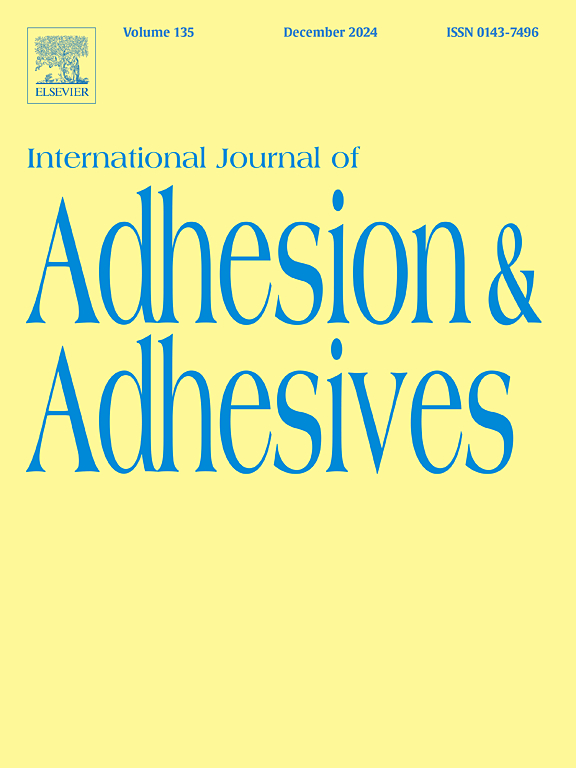木质纤维素废弃物中糠醛基生物树脂的开发与表征
IF 3.2
3区 材料科学
Q2 ENGINEERING, CHEMICAL
International Journal of Adhesion and Adhesives
Pub Date : 2025-03-14
DOI:10.1016/j.ijadhadh.2025.104014
引用次数: 0
摘要
在日益增长的环境问题和可持续性需求的推动下,生物基树脂已成为木制品行业中化石基树脂的有前途的替代品。虽然传统的甲醛基树脂以低成本提供牢固的粘合,但它们存在明显的缺点,包括有害排放物和较差的耐水性。本研究探索了一种从多种木质纤维素来源合成生物树脂的新方法:甘蔗甘蔗渣、桦木、银柏木和中密度纤维板(MDF)废料,使用氯化氢气体进行酸水解。研究的重点是通过三个阶段的过程:控制酸水解、提取和原料氧化浓度来开发糠醛树脂。我们采用多种表征技术-光谱分析,热测试和流变学测量-来评估树脂的化学成分,热稳定性和粘弹性行为。在所有测试的原料中,甘蔗渣衍生树脂表现出优异的性能,实现了最高的糠醛收率(31.6%),并表现出优异的耐水性和热稳定性。这些增强的性能源于有效的交联和材料的天然高戊聚糖含量。桦木和mdf衍生树脂表现出中等的性能特征,而柏木树脂的稳定性和生产效率较低,反映了原料成分的变化。我们的研究结果表明,生物树脂,特别是从蔗渣等农业残留物中提取的生物树脂,在工业应用中代表了合成树脂的可行替代品。本研究为优化环保树脂生产中可再生材料的利用奠定了基础,支持木材行业向更可持续的制造实践过渡。本文章由计算机程序翻译,如有差异,请以英文原文为准。
Development and characterization of furfural-based bio-resins from lignocellulosic waste for eco-friendly wood resins
Bio-based resins have emerged as promising alternatives to fossil-based resins in the wood products industry, driven by growing environmental concerns and sustainability demands. While traditional formaldehyde-based resins offer strong bonding at low cost, they present significant drawbacks, including hazardous emissions and poor water resistance. This study explores a novel approach to synthesizing bio-resins from diverse lignocellulosic sources: sugarcane bagasse, birch wood, silver cypress wood, and medium-density fiberboard (MDF) waste, using hydrogen chloride gas for acid hydrolysis. The research focused on developing furfural-based resins through a three-stage process: controlled acid hydrolysis, extraction, and oxidative concentration of the feedstock materials. We employed multiple characterization techniques—spectroscopic analysis, thermal testing, and rheological measurements—to evaluate the resins' chemical composition, thermal stability, and viscoelastic behavior. Among all feedstocks tested, bagasse-derived resin demonstrated superior performance, achieving the highest furfural yield (31.6 %) and exhibiting exceptional water resistance and thermal stability. These enhanced properties stemmed from efficient cross-linking and the material's naturally high pentosan content. Birch and MDF-derived resins showed intermediate performance characteristics, while cypress-based resins yielded lower stability and production efficiency, reflecting variations in source material composition. Our findings establish that bio-resins, particularly those derived from agricultural residues like bagasse, represent viable replacements for synthetic resins in industrial applications. This research lays the groundwork for optimizing renewable material utilization in eco-friendly resin production, supporting the wood industry's transition toward more sustainable manufacturing practices.
求助全文
通过发布文献求助,成功后即可免费获取论文全文。
去求助
来源期刊

International Journal of Adhesion and Adhesives
工程技术-材料科学:综合
CiteScore
6.90
自引率
8.80%
发文量
200
审稿时长
8.3 months
期刊介绍:
The International Journal of Adhesion and Adhesives draws together the many aspects of the science and technology of adhesive materials, from fundamental research and development work to industrial applications. Subject areas covered include: interfacial interactions, surface chemistry, methods of testing, accumulation of test data on physical and mechanical properties, environmental effects, new adhesive materials, sealants, design of bonded joints, and manufacturing technology.
 求助内容:
求助内容: 应助结果提醒方式:
应助结果提醒方式:


